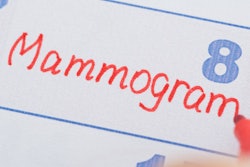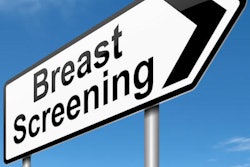False positives and overdiagnosis related to mammography screening cost the U.S. $4 billion per year, a figure that's much higher than previous estimates, according to a study published in Health Affairs. But the study's findings are based on previous research that has already been criticized by advocates of screening.
Researchers Mei-Sing Ong, PhD, and colleague Dr. Kenneth Mandl from Boston Children's Hospital used data taken from two controversial papers to assess costs associated with false-positive mammograms and overdiagnosis of screen-detected breast cancer in women between the ages of 40 and 49.
The study included data from 702,154 female beneficiaries of a major U.S. healthcare insurer who had routine mammography screening in 2012 and who were continuously enrolled in the health plan for a year following the initial screening mammogram (Health Affairs, April 6, 2015).
Ong and Mandl evaluated two mammography screening outcomes: false-positive mammograms, which they defined as exams that led to further diagnostic workup (more mammography or a biopsy) but did not result in a breast cancer diagnosis, and screen-detected breast cancer. The researchers conceded that they could not distinguish which cancers were overdiagnosed from the actual patient data they analyzed, so they extrapolated the data using figures taken from recent studies.
The researchers evaluated the use of medical services related to breast cancer in the 12 months after the initial screening exam: mammography screening, diagnostic mammography, other imaging exams, chemotherapy, radiation therapy, pathology, outpatient consults, inpatient services, anesthesia, and medications. They defined costs as the total amount paid by the insurer -- excluding patient co-pays, additional insurance, and deductibles -- and used the average cost for diagnosing and treating a screen-detected breast cancer to estimate overdiagnosis.
Of the study cohort, 11.1% of patients received a false-positive mammogram, and the average expense per false-positive mammogram was $852, according to Ong and Mandl. Of the women included in the study, 0.4% were diagnosed with invasive breast cancer, and 0.01% were found to have ductal carcinoma in situ (DCIS). The average cost of medical services for each invasive breast cancer was $51,837, and the average cost of treating DCIS was $12,369, the researchers wrote.
To estimate how many screen-detected cancers were overdiagnosed, Ong and Mandl applied an overdiagnosis rate of 22% found in two controversial studies: one conducted by Dr. Archie Bleyer and colleague Dr. H. Gilbert Welch (New England Journal of Medicine, November 22, 2012, Vol. 367:21, pp. 1998-2005) and the other by Dr. Anthony Miller (BMJ, February 11, 2014).
To estimate the amount of DCIS that was overdiagnosed, the researchers referred to results from a study conducted by Dr. G.D. Leonard, which found that 86% of women with DCIS were overdiagnosed (Journal of the National Cancer Institute, June 16, 2004, Vol. 96:12, pp. 906-920).
"The costs of false-positive mammography results and breast cancer overdiagnosis in women
ages 40-59 are substantial," Ong and Mandl wrote. "[If] we assume a false-positive rate of 11% and an overdiagnosis rate of 22% and 86% for invasive breast cancer and DCIS, respectively, the estimated annual national expenditure for false-positive mammograms and overdiagnoses of breast cancer is about $4 billion."
The study shows that the costs of breast cancer diagnosis and treatment are much higher than previously thought -- which could influence screening protocols, the researchers concluded.
"Such high diagnostic and treatment costs may tilt the balance to the point where screening appears relatively cost-ineffective, particularly if the disutility of overdiagnosis is considered," they wrote.




















